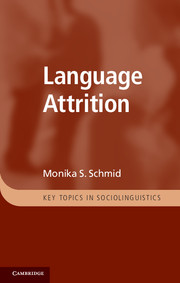Book contents
- Frontmatter
- Contents
- List of figures
- List of tables
- Preface
- Abbreviations
- 1 Introduction
- Part I Linguistic aspects of language attrition
- Part II Extralinguistic aspects of language attrition
- Part III Conducting research on language attrition – preliminary considerations
- Part IV Experimental designs for attrition research – the language attrition test battery
- Part V Coding and analysing the data
- 18 Conclusion
- Glossary
- Notes
- References
- Index
Part II - Extralinguistic aspects of language attrition
Published online by Cambridge University Press: 05 June 2012
- Frontmatter
- Contents
- List of figures
- List of tables
- Preface
- Abbreviations
- 1 Introduction
- Part I Linguistic aspects of language attrition
- Part II Extralinguistic aspects of language attrition
- Part III Conducting research on language attrition – preliminary considerations
- Part IV Experimental designs for attrition research – the language attrition test battery
- Part V Coding and analysing the data
- 18 Conclusion
- Glossary
- Notes
- References
- Index
Summary
Surely it all very much depends on personal circumstances i.e. background, age, time of emigration amongst others.
(Letter from Sigmund W.)In Part I you were introduced to some of the characteristics of attrited languages. I tried to address questions such as: how can two languages intermingle in the attritional process? To what extent can aspects of an attriting language become reduced or simplified? And, on the other hand: which parts of the linguistic system are relatively stable and less vulnerable to attrition?
When you are investigating a group of speakers who have experienced language attrition, you may expect to find some or all of these characteristics in the way in which they use their first language. What you may also expect, however, is that some speakers will have a far higher amount of attritional features than others. In Part II we will look at the reasons for this difference.
Let us again start with the two speakers to whom I introduced you at the beginning of this book, Gertrud U. and Albert L. You saw in the last chapters that there is a striking difference in the amount of attrition to be found in their speech: Gertrud U. was noticeably disfluent, used a simplified lexicon, and had a range of non-targetlike structures, including an English accent. Albert L., on the other hand, would probably only be perceptibly different from a non-attrited native speaker on much closer investigation.
- Type
- Chapter
- Information
- Language Attrition , pp. 69 - 70Publisher: Cambridge University PressPrint publication year: 2011

